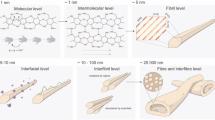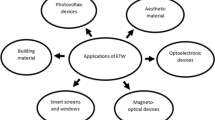Abstract
A new molecular model is developed for wood moisture sorption in the hygroscopic range of relative humidity (RH < 95%). This model incorporates realistic physical characteristics of wood moisture sorption that cannot be explained by commonly used moisture sorption theories. The model considers a fixed number of active sorption sites over the full hygroscopic RH range. Each site is constituted by a pair of wood hydroxyl groups, which may be occupied by single or dimerized water species. The equilibrium occupation statistics of the sorption sites are controlled by the temperature and RH conditions and appear generally applicable to wood as well as modified wood. The relative amounts of monomer and dimer water can be calculated from the model for any equilibrium moisture content at any temperature and RH, which can be used for future spectroscopic identification and verification. The sigmoid wood moisture adsorption isotherm is calculated to be exclusively composed of monomers at low RH < 50%, while at RH = 100%, moisture is exclusively bound as water dimers, which is supported by a statistical cluster calculation. This state change in adsorbed water species from strongly bound monomers at low RH to relatively loosely bound dimers at high RH fundamentally differs from multilayer or hydration sorption models where a monolayer of strongly bound water remains present at high RH as a substrate layer for loosely bound secondary water.





Similar content being viewed by others
References
Altgen M, Militz H (2016) Influence of process conditions on hygroscopicity and mechanical properties of European beech thermally modified in a high-pressure reactor system. Holzforschung 70:971–979
Altgen M, Uimonen T, Rautkari L (2018) The effect of de- and re-polymerization during heat-treatment on the mechanical behavior of Scots pine sapwood under quasi-static load. Polym Degrad Stab 147:197–205
Beck G, Strohbusch S, Larnøy E, Militz H, Hill C (2018) Accessibility of hydroxyl groups in anhydride modified wood as measured by deuterium exchange and saponification. Holzforschung 72(1):17–23
Berthold J, Rinaudo M, Salmén L (1996) Association of water to polar groups; estimations by an adsorption model for ligno-cellulosic materials. Colloids Surf A Physicochem Eng Asp 112:117–129
Chaouch M, Dumarçay S, Pétrissans A, Pétrissans M, Gérardin P (2013) Effect of heat treatment on some conferred properties of different European softwood and hardwood species. Wood Sci Technol 47:663–673
Cox J, McDonald PJ, Gardiner BA (2010) A study of water exchange in wood by means of 2D NMR relaxation correlation and exchange. Holzforschung 64:259–266
Dieste A, Krause A, Mai C, Militz H (2010) The calculation of EMC for the analysis of wood/water relations in Fagus sylvatica L. modified with 1, 3-dimethylol-4, 5-dihydroxyethyleneurea. Wood Sci Technol 44:597–606
Engelund ET, Thygesen LG, Svensson S, Hill CAS (2013) A critical discussion of the physics of wood–water interactions. Wood Sci Technol 47:141–161
Fackler K, Schwanninger M (2012) How spectroscopy and microspectroscopy of degraded wood contribute to understand fungal wood decay. Appl Microbiol Biotechnol 96:587–599
Gezici-Koç Ö, Erich SJ, Huinink HP, van der Ven LG, Adan OC (2017) Bound and free water distribution in wood during water uptake and drying as measured by 1D magnetic resonance imaging. Cellulose 24:535–553
Glass SV, Zelinka SL (2010) Moisture relations and physical properties of wood. In: Ross RJ (ed) Wood handbook, Chapter 04. Forest Products Laboratory, Madison
Glass SV, Zelinka SL, Johnson JA (2014) Investigation of historic equilibrium moisture content data from the forest products laboratory. General technical report FPL–GTR–229. Forest Products Laboratory, Madison
Glass SV, Boardman CR, Zelinka SL (2017) Short hold times in dynamic vapor sorption measurements mischaracterize the equilibrium moisture content of wood. Wood Sci Technol 51:243–260
Hancock BC, Zografi G (1993) The use of solution theories for predicting water vapor absorption by amorphous pharmaceutical solids: a test of the Flory–Huggins and Vrentas models. Pharm Res 10:1262–1267
Hartley ID, Kamke FA, Peemoeller H (1992) Cluster theory for water sorption in wood. Wood Sci Technol 26:83–99
Hartley ID, Avramidis S, MacKay A (1996) H-NMR studies of water interactions in sitka spruce and western hemlock: moisture content determination and second moments. Wood Sci Technol 30:141–148
Hill CAS (2006) Wood modification: chemical, thermal and other processes. Wiley, Chichester
Hill C, Beck G (2017) On the applicability of the Flory–Huggins and Vrentas models for describing the sorption isotherms of wood. Int Wood Prod J 8:50–55
Himmel S, Mai C (2016) Water vapour sorption of wood modified by acetylation and formalisation—analysed by a sorption kinetics model and thermodynamic considerations. Holzforschung 70:203–213
Jeffrey GA, Saenger W (1994) Hydrogen bonding in biological structures, 2nd edn. Springer, Heidelberg
Kelsey KE (1957) The sorption of water vapour by wood. Aust J Appl Sci 8:42–54
Keutsch FN, Saykally RJ (2001) Water clusters: untangling the mysteries of the liquid, one molecule at a time. Proc Natl Acad Sci USA 98:10533–10540
Krupińska B, Strømmen I, Pakowski Z, Eikevik TM (2007) Modeling of sorption isotherms of various kinds of wood at different temperature conditions. Dry Technol 25:1463–1470
Kulasinski K, Guyer R, Derome D, Carmeliet J (2015) Poroelastic model for adsorption-induced deformation of biopolymers obtained from molecular simulations. Phys Rev E 92:02260578
Mitsui K, Inagaki T, Tsuchikawa S (2008) Monitoring of hydroxyl groups in wood during heat treatment using NIR spectroscopy. Biomacromol 9:286–288
O’Neill H, Pingali SV, Petridis L, He J, Mamontov E, Hong L, Urban V, Evans B, Langan P, Smith JC, Davison BH (2017) Dynamics of water bound to crystalline cellulose. Sci Rep 7:11840
Obataya E, Tomita B (2002) Hygroscopicity of heat-treated wood II. Reversible and irreversible reductions in the hygroscopicity of wood due to heating. Mokuzai Gakkaishi 48:288–295
Olsson AM, Salmén L (2004) The association of water to cellulose and hemicellulose in paper examined by FTIR spectroscopy. Carbohydr Res 339:813–818
Papadopoulos AN, Hill CAS (2003) The sorption of water vapour by anhydride modified softwood. Wood Sci Technol 37:221–231
Papadopoulos AN, Mantanis G (2012) Vapour sorption studies of Belmadur wood. Adv For Lett 1:1–6
Passarini L, Malveau C, Hernández RE (2015) Distribution of the equilibrium moisture content in four hardwoods below fiber saturation point with magnetic resonance microimaging. Wood Sci Technol 49:1251–1268
Peleg M (1993) Assessment of a semi-empirical four parameter general model for sigmoid moisture sorption isotherms. Food Process Eng 16:21–37
Phuong L, Takayama M, Shida S, Matsumoto Y, Aoyagi T (2007) Determination of the accessible hydroxyl groups in heat-treated Styrax tonkinensis (Pierre) Craib ex Hartwich wood by hydrogen–deuterium exchange and 2H NMR spectroscopy. Holzforschung 61:488–491
Plaza NZ, Pingali SV, Qian S, Heller WT, Jakes JE (2016) Informing the improvement of forest products durability using small angle neutron scattering. Cellulose 23:1593–1607
Popescu CM, Hill CAS, Curling S, Jalaludin Z, Xie Y (2014) The water vapour sorption behaviour of acetylated birch wood: how acetylation affects the sorption isotherm and accessible hydroxyl content. J Mater Sci 49:2362–2371
Popper R, Niemz P, Croptier S (2009) Adsorption and desorption measurements on selected exotic wood species. Analysis with the Hailwood–Horrobin model to describe the sorption hysteresis. Wood Res 54:43–56
Rautkari L, Hill CAS, Curling S, Jalaludin Z, Ormondroyd G (2013) What is the role of the accessibility of wood hydroxyl groups in controlling moisture content? J Mater Sci 48:6352–6356
Rosenbaum S (1970) Solution of water in polymers: the Keratin-Water isotherm. J Polym Sci Polym Symp 31:45–55
Ruckenstein E, Shulgin IL (2009) Thermodynamics of solutions. Springer, New York
Salmén L, Possler H, Stevanic JS, Stanzl-Tschegg SE (2008) Analysis of thermally treated wood samples using dynamic FT-IR-spectroscopy. Holzforschung 62:676–678
Seborg RM, Tarkow H, Stamm AJ (1953) Effect of heat upon the dimensional stabilization of wood. J For Prod Res Soc 3:59–67
Shi J, Avramidis S (2017) Water sorption hysteresis in wood: III physical modeling by molecular simulation. Holzforschung 71:733–741
Sinibaldi R, Ortore MG, Spinozzi F, de Souza Funari S, Teixeira J, Mariani P (2008) SANS/SAXS study of the BSA solvation properties in aqueous urea solutions via a global fit approach. Eur Biophys J 37:673–681
Skaar C (1988) Wood–water relations. Springer, Berlin
Steiner T (2002) The hydrogen bond in the solid state. Angew Chem Int Ed 41:48–76
Taniguchi T, Harada H, Nakato K (1978) Determination of water adsorption sites in wood by a hydrogen–deuterium exchange. Nature 272:230–231
Thibault X (2012) Neutron techniques for wood chemistry. Cellul Chem Technol 46:421–425
Vrentas JS, Vrentas CM (1996) Hysteresis effects for sorption in glassy polymers. Macromolecules 29:4391–4396
Weichert L (1963) Untersuchungen über das Sorption- und Quellungsverhalten von Fichte, Buche und Buchen-Preßvollholz bei Temperaturen zwischen 20 ° und 100 °C (Investigations on sorption and swelling of spruce, beech and compressed-beech wood at temperatures between 20 °C and 100 °C) (In German). Holz Roh Werkst 21:290–300
Willems W (2014a) The hydrostatic pressure and temperature dependence of wood moisture sorption isotherms. Wood Sci Technol 48:483–498
Willems W (2014b) The water vapor sorption mechanism and its hysteresis in wood: the water/void mixture postulate. Wood Sci Technol 48:499–518
Willems W (2015) A critical review of the multilayer sorption models and comparison with the sorption site occupancy (SSO) model for wood moisture sorption isotherm analysis. Holzforschung 69:67–75
Willems W (2016) Equilibrium thermodynamics of wood moisture revisited: presentation of a simplified theory. Holzforschung 70:963–970
Xie Y, Hill CAS, Xiao Z, Mai C, Militz H (2011) Dynamic water vapour sorption properties of wood treated with glutaraldehyde. Wood Sci Technol 45:49–61
Zaihan J, Hill CAS, Curling S, Hashim WS, Hamdan H (2009) Moisture adsorption isotherms of Acacia mangium and Endospermum malaccense using dynamic vapour sorption. J Trop For Sci 21:277–285
Zimm BH (1953) Simplified relation between thermodynamics and molecular distribution functions for a mixture. J Chem Phys 21:934–935
Zimm BH, Lundberg JL (1956) Sorption of vapors by high polymers. J Phys Chem 60:425–428
Author information
Authors and Affiliations
Corresponding author
Electronic supplementary material
Below is the link to the electronic supplementary material.
Rights and permissions
About this article
Cite this article
Willems, W. Hygroscopic wood moisture: single and dimerized water molecules at hydroxyl-pair sites?. Wood Sci Technol 52, 777–791 (2018). https://doi.org/10.1007/s00226-018-0998-x
Received:
Published:
Issue Date:
DOI: https://doi.org/10.1007/s00226-018-0998-x




